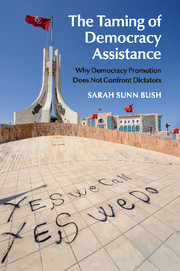Book contents
- Frontmatter
- Contents
- List of figures
- List of tables
- Preface
- List of abbreviations
- Part I Introduction and argument
- Part II Testing the argument
- 4 Delegation and the allocation of democracy assistance
- 5 Changes in American grant-making
- 6 Creating the democracy establishment
- 7 Jordan: aid in the shadow of geopolitics
- 8 Tunisia: reform after revolution
- Part III Conclusions
- Part IV Appendices and references
6 - Creating the democracy establishment
from Part II - Testing the argument
Published online by Cambridge University Press: 05 May 2015
- Frontmatter
- Contents
- List of figures
- List of tables
- Preface
- List of abbreviations
- Part I Introduction and argument
- Part II Testing the argument
- 4 Delegation and the allocation of democracy assistance
- 5 Changes in American grant-making
- 6 Creating the democracy establishment
- 7 Jordan: aid in the shadow of geopolitics
- 8 Tunisia: reform after revolution
- Part III Conclusions
- Part IV Appendices and references
Summary
I had to spend all this time with my staff figuring out from our own beneficiaries how many town hall meetings were held in village X to send to USAID in Macedonia, to send to USAID in Washington, to send to Congress. And you think, “Oh my God, is this really how we measure impact? It's so trivial and silly!” But it's what you have to do.
In 1941, a group of activists in New York City – Herbert and Eleanor Agar, Dorothy Thompson, George Field, and Ulric Bell – united to form Freedom House at the behest of President Franklin D. Roosevelt. At the time, the United States had no formal involvement in World War II. Given that context, the hawkish activists sought to combat two things: the propaganda emanating from the Nazis’ Braunes Haus in Munich and the isolationism of the American public. After the war, Freedom House shifted to supporting the post-war liberal international order and civil rights at home. The organization furthered its agenda through policy statements and research reports, which it financed through membership fees and special events.
By the turn of the twenty-first century, Freedom House was one of the most active, professional organizations in the democracy establishment. It describes itself “an independent watchdog organization that supports the expansion of freedom around the world. Freedom House supports democratic change, monitors freedom, and advocates democracy and human rights.” Its 120 staff members in more than one dozen global offices design and implement democracy-assistance projects that are largely funded by the United States government. Such programs support the rule of law, strengthen civil society organizations, and encourage women's political participation, among other things. Staff also advance Freedom House's mission through research, including through creating indices measuring aspects of democracy. The organization's domestic activities ceased long ago, and its international programs have also changed considerably over time.
- Type
- Chapter
- Information
- The Taming of Democracy AssistanceWhy Democracy Promotion Does Not Confront Dictators, pp. 131 - 158Publisher: Cambridge University PressPrint publication year: 2015

